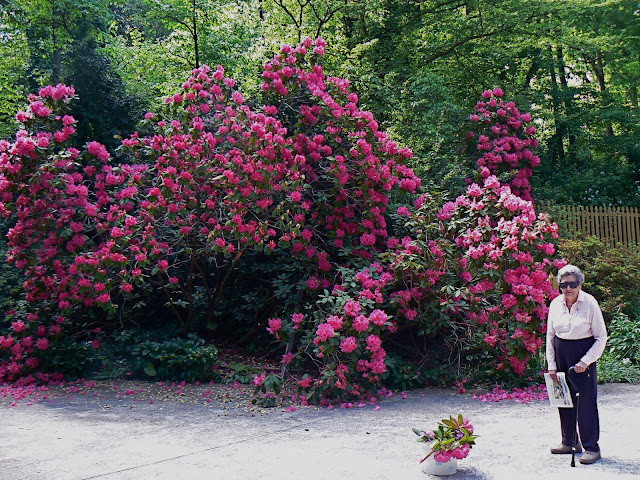This photograph is fuzzy, but it tells a story. The glossy picture was given to me by my late friend Mary Ann Gatlin. I used to spend hours at her house (above), admiring all the plants she grew. The description "green thumb" could have been invented by this incredible gardener and propagator.
To make ends meet, Mary Ann ran a booth at the old Municipal Market downtown next to Grady Hospital (now Sweet Auburn Curb Market). Her best-selling merchandise there consisted of funeral stands and wreaths made of plastic flowers. That's what helped put food on the table, but her heart was elsewhere.
At her home on a lovely street in Decatur, she was always growing unusual plants of the highest quality, both for indoors and for the garden. In her greenhouse, she had the most fabulous succulents and ferns and unusual houseplants. On her back patio, she would combine the succulents in all sorts of containers - broken down chairs, bicycle baskets, concrete planters she decorated herself and large troughs.
Mary Ann's mother Ida Mae had been in the florist business at the Municipal Market. When Mary Ann was younger, much to her embarrassment, her mother would ride around Atlanta hunting for plants in people's yards.
One day in the 1960's, Ida Mae hit the jackpot. The Gatlins pulled up to a house in east Atlanta, and Ida Mae bought some daisies she'd been eyeing for quite a while. She planted them out and realized that she had a daisy that bloomed later than the well-known shasta types. This one had thick, upright basal foliage, from which the daisies shot up on single, sturdy stems, making it a good cut flower. In addition, the plants spread readily, and the foliage was attractive even by itself. There was no flopping over of these daisies.
The Gatlins shared the daisies with friends and neighbors, and Ida Mae sold plants at the market. One day in the mid-eighties, nurseryman Bill Funkhouser noticed the daisy at Becky and Jimmy Stewart's house up the street from the Gatlins. He took cuttings and began to sell the plant as 'Becky'. Meanwhile, Bud Heist, a grower and friend of the Gatlins was selling the daisy as 'Ida Mae'.
About the same time, plantsman and garden designer Ryan Gainey gave the daisy to the owners of Goodness Grows in east Georgia. They dubbed the perennial 'Ryan's Daisy'.
Now, while all this was happening in the eighties, I also had this daisy. I bought it in the late seventies from a lady named Mrs. Sonet (not sure of the spelling) who advertised in the Market Bulletin. It was said that if you went to her house off Northside Drive in Atlanta and she liked you, she would sell you her plants. If not, she sent you away empty-handed. I stood in the background while my friend charmed Mrs. Sonet, and we left with a couple dozen plants that we called 'Mrs. Sonet's Daisy' (the small tufts cost 10 cents each). They spread quickly, and I gave a lot away.
I may not know the full story, but Mary Ann never said anything to me about the fact that the daisy her mother found ended up being called 'Becky'. As far as I know, Mary Ann Gatlin was just happy that this great perennial was getting out there where gardeners everywhere would have a chance to grow it. In 2003, the Perennial Plant Association named Leucanthemum 'Becky' the perennial plant of the year.
'Mrs. Sonet's Daisy', 'Ida Mae', 'Ryan's Daisy', 'Becky' - all the same plant and one you should have in your garden. Plant in sun in soil that is well drained. White blooms with yellow centers appear in June and last through September. 'Becky' will even tolerate a bit of shade and still remain upright.














